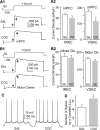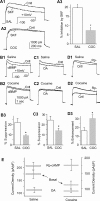Cocaine-induced plasticity of intrinsic membrane properties in prefrontal cortex pyramidal neurons: adaptations in potassium currents
- PMID: 15673674
- PMCID: PMC6725625
- DOI: 10.1523/JNEUROSCI.4715-04.2005
Cocaine-induced plasticity of intrinsic membrane properties in prefrontal cortex pyramidal neurons: adaptations in potassium currents
Abstract
Drug-induced adaptations in the prefrontal cortex (PFC) contribute to several core aspects of addictive behaviors, but the underlying neuronal processes remain essentially unknown. Here, we demonstrate that repeated in vivo exposure to cocaine persistently reduces the voltage-gated K+ current (VGKC) in PFC pyramidal neurons, resulting in enhanced membrane excitability. Analysis of dopamine D1-class receptor (D1R)-mediated modulation of VGKC indicates that, despite the absence of direct D1R stimulation, downstream D1 signaling (the cAMP/protein kinase A pathway) is increased during withdrawal from chronic cocaine treatment and plays a central role in the drug-induced membrane plasticity in PFC. This long-lasting, cocaine-induced plasticity of membrane excitability in PFC pyramidal neurons may contribute to the impaired decision making and drug craving that characterize cocaine withdrawal.
Figures



Similar articles
-
Dopamine modulates an mGluR5-mediated depolarization underlying prefrontal persistent activity.Nat Neurosci. 2009 Feb;12(2):190-9. doi: 10.1038/nn.2245. Epub 2009 Jan 25. Nat Neurosci. 2009. PMID: 19169252 Free PMC article.
-
Repeated cocaine administration promotes long-term potentiation induction in rat medial prefrontal cortex.Cereb Cortex. 2007 Aug;17(8):1877-88. doi: 10.1093/cercor/bhl096. Epub 2006 Oct 18. Cereb Cortex. 2007. PMID: 17050645
-
Repeated cocaine administration increases membrane excitability of pyramidal neurons in the rat medial prefrontal cortex.J Pharmacol Exp Ther. 2005 Mar;312(3):1305-13. doi: 10.1124/jpet.104.075184. Epub 2004 Dec 1. J Pharmacol Exp Ther. 2005. PMID: 15574686
-
Stress Impairs Prefrontal Cortical Function via D1 Dopamine Receptor Interactions With Hyperpolarization-Activated Cyclic Nucleotide-Gated Channels.Biol Psychiatry. 2015 Dec 15;78(12):860-70. doi: 10.1016/j.biopsych.2015.01.009. Epub 2015 Feb 4. Biol Psychiatry. 2015. PMID: 25731884 Free PMC article.
-
Dopamine D1-class receptors selectively modulate a slowly inactivating potassium current in rat medial prefrontal cortex pyramidal neurons.J Neurosci. 2003 Apr 1;23(7):2686-95. doi: 10.1523/JNEUROSCI.23-07-02686.2003. J Neurosci. 2003. PMID: 12684454 Free PMC article.
Cited by
-
Exposure to cocaine dynamically regulates the intrinsic membrane excitability of nucleus accumbens neurons.J Neurosci. 2010 Mar 10;30(10):3689-99. doi: 10.1523/JNEUROSCI.4063-09.2010. J Neurosci. 2010. PMID: 20220002 Free PMC article.
-
Dopamine modulates an mGluR5-mediated depolarization underlying prefrontal persistent activity.Nat Neurosci. 2009 Feb;12(2):190-9. doi: 10.1038/nn.2245. Epub 2009 Jan 25. Nat Neurosci. 2009. PMID: 19169252 Free PMC article.
-
Long latency of evoked quantal transmitter release from somata of locus coeruleus neurons in rat pontine slices.Proc Natl Acad Sci U S A. 2007 Jan 23;104(4):1401-6. doi: 10.1073/pnas.0608897104. Epub 2007 Jan 16. Proc Natl Acad Sci U S A. 2007. PMID: 17227848 Free PMC article.
-
Prefrontal Neuronal Excitability Maintains Cocaine-Associated Memory During Retrieval.Front Behav Neurosci. 2018 Jun 14;12:119. doi: 10.3389/fnbeh.2018.00119. eCollection 2018. Front Behav Neurosci. 2018. PMID: 29962941 Free PMC article.
-
Impact of Acute and Persistent Excitation of Prelimbic Pyramidal Neurons on Motor Activity and Trace Fear Learning.J Neurosci. 2021 Feb 3;41(5):960-971. doi: 10.1523/JNEUROSCI.2606-20.2020. Epub 2021 Jan 5. J Neurosci. 2021. PMID: 33402420 Free PMC article.
References
-
- Damasio AR (1995) On some functions of the human prefrontal cortex. Ann NY Acad Sci 769: 241-251. - PubMed
Publication types
MeSH terms
Substances
Grants and funding
LinkOut - more resources
Full Text Sources
Miscellaneous
